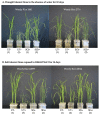A Symbiotic Approach to Generating Stress Tolerant Crops
- PMID: 33922997
- PMCID: PMC8145319
- DOI: 10.3390/microorganisms9050920
A Symbiotic Approach to Generating Stress Tolerant Crops
Abstract
Studies were undertaken to determine if fungal endophytes from plants in stressful habitats could be commercialized to generate climate resilient crop plants. Fungal endophytes were isolated from weedy rice plants and grasses from South Korea and the USA, respectively. Endophytes (Curvularia brachyspora and Fusarium asiaticum) from weedy rice plants from high salt or drought stressed habitats in South Korea conferred salt and drought stress tolerance to weedy rice and commercial varieties reflective of the habitats from which they were isolated. Fungal endophytes isolated from grasses in arid habitats of the USA were identified as Trichoderma harzianum and conferred drought and heat stress tolerance to monocots and eudicots. Two T. harzianum isolates were exposed to UV mutagenesis to derive strains resistant to fungicides in seed treatment plant protection packages. Three strains that collectively had resistance to commonly used fungicides were used for field testing. The three-strain mixture (ThSM3a) increased crop yields proportionally to the level of stress plants experienced with average yields up to 52% under high and 3-5% in low stress conditions. This study demonstrates fungal endophytes can be developed as viable commercial tools for rapidly generating climate resilient crops to enhance agricultural sustainability.
Keywords: abiotic stress tolerance; agriculture; fungal endophytes; symbiosis.
Conflict of interest statement
The authors declare no conflict of interest.
Figures












Similar articles
-
Stress tolerance in plants via habitat-adapted symbiosis.ISME J. 2008 Apr;2(4):404-16. doi: 10.1038/ismej.2007.106. Epub 2008 Feb 7. ISME J. 2008. PMID: 18256707
-
Fungal Endophytes Promote Tomato Growth and Enhance Drought and Salt Tolerance.Plants (Basel). 2020 Jul 10;9(7):877. doi: 10.3390/plants9070877. Plants (Basel). 2020. PMID: 32664321 Free PMC article.
-
Desert-adapted fungal endophytes induce salinity and drought stress resistance in model crops.Plant Physiol Biochem. 2021 Mar;160:225-238. doi: 10.1016/j.plaphy.2021.01.022. Epub 2021 Jan 21. Plant Physiol Biochem. 2021. PMID: 33517220
-
Do fungal-endosymbionts improve crop nutritional quality and tolerance to stress by boosting flavonoid-mediated responses?Food Res Int. 2022 Nov;161:111850. doi: 10.1016/j.foodres.2022.111850. Epub 2022 Aug 27. Food Res Int. 2022. PMID: 36192976 Review.
-
More than 400 million years of evolution and some plants still can't make it on their own: plant stress tolerance via fungal symbiosis.J Exp Bot. 2008;59(5):1109-14. doi: 10.1093/jxb/erm342. Epub 2008 Feb 10. J Exp Bot. 2008. PMID: 18267941 Review.
Cited by
-
Disclosing the native blueberry rhizosphere community in Portugal-an integrated metagenomic and isolation approach.PeerJ. 2023 Jun 27;11:e15525. doi: 10.7717/peerj.15525. eCollection 2023. PeerJ. 2023. PMID: 37397024 Free PMC article.
-
Fungal Endophytes to Combat Biotic and Abiotic Stresses for Climate-Smart and Sustainable Agriculture.Front Plant Sci. 2022 Jul 5;13:953836. doi: 10.3389/fpls.2022.953836. eCollection 2022. Front Plant Sci. 2022. PMID: 35865289 Free PMC article. Review.
-
Bioactive compounds of Curvularia species as a source of various biological activities and biotechnological applications.Front Microbiol. 2022 Dec 8;13:1069095. doi: 10.3389/fmicb.2022.1069095. eCollection 2022. Front Microbiol. 2022. PMID: 36569099 Free PMC article. Review.
-
Biotech Application of Exopolysaccharides from Curvularia brachyspora: Optimization of Production, Structural Characterization, and Biological Activity.Molecules. 2023 May 26;28(11):4356. doi: 10.3390/molecules28114356. Molecules. 2023. PMID: 37298832 Free PMC article.
-
Microorganisms in Plant Growth and Development: Roles in Abiotic Stress Tolerance and Secondary Metabolites Secretion.Microorganisms. 2022 Jul 28;10(8):1528. doi: 10.3390/microorganisms10081528. Microorganisms. 2022. PMID: 36013946 Free PMC article. Review.
References
-
- [(accessed on 20 April 2021)]; Available online: http://www.copenhagendiagnosis.com.
-
- FAO . 20 Things to Know about the Impact of Salt Water on Agricultural Land in Aceh Province. FAO; Rome, Italy: 2005. [(accessed on 20 April 2021)]. FAO Field Guide. Available online: http://www.fao.org/ag/tsunami/docs/saltwater-guide.pdf.
-
- Van Nguyen N., Ferrero A. Meeting the challenges of global rice production. Paddy Water Environ. 2006;4:1–9. doi: 10.1007/s10333-005-0031-5. - DOI
Grants and funding
LinkOut - more resources
Full Text Sources

